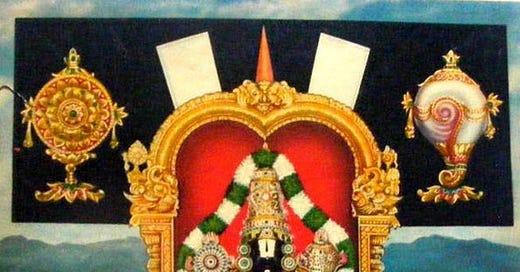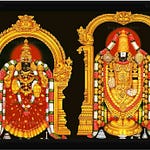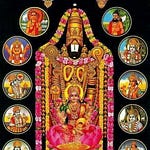Where verse 26 described the human devotees, the true Śrīvaiṣṇavas, who gather every morning to greet Lord Śrīnivāsa, and where a number of earlier verses sang of the different groups of gods and sages who pay their respects early in the morning, verse 27 now finally collects everybody across the cosmos.
Brahmā-ādayaḥ sura-varāḥ sa-maharṣayas te santaḥ Sanandana-mukhās tv atha yogi-varyāḥ | dhāmântike tava hi maṅgala-vastu-hastāḥ Śrī-Veṅkaṭâcala-pate! tava suprabhātam || (VSu 27)
The best of the gods with Brahmā at their head, alongside the great Seers, the saints, Sanandana and His companions, and the best of yogins are all at Your sanctum bearing auspicious paraphernalia in their hands: O Lord of the sacred mountain wealth-weaving, sin-cleaving Veṅkaṭam, a blessed morning unto You!
Echoes of the Tirup-paḷḷi-yĕḻucci
This verse captures the spirit of a number of verses of Tŏṇḍar-aḍip-pŏḍi Āḻvār’s Tirup-paḷḷi-yĕḻucci, all of which similarly describe different groups of divine beings coming to awaken (in that song) Lord Raṅganātha of Śrīraṅgam. Verses 7 and 8 of the TPĔ, which we will now take a look at, are perhaps the closest match to this verse in spirit and in content:
andarattu Amarargaḷ kūṭṭaṅgaḷ ivaiyō? arun-tava munivarum marutarum ivarō? Indiran ānaiyum tānum vandu ivanō? Ĕmpĕrumān un kōyil-in vāśal Sundarar nĕrukka, Viccādarar nūkka, Iyakkarum mayaṅginar tiru-vaḍi toḻuvān, andaram pār iḍam illai maṯṯṟu iduvō? Araṅgattu Ammā! paḷḷi yĕḻundu aruḷāyē (TPĔ 7) vambu-aviḻ vānavar vāyurai vaḻaṅga mā-nidhi kapilai yŏṇ-kaṇṇāḍi mudalā Ĕmpĕrumān paḍi makkalam kāṇḍarku ērpana vāyina koṇḍu nal-munivar Tumburu, Nāradar pugundanar ivarō? tōṉḏṟinan iRaviyum tulaṅg’ oḷi parappi, ambara-talattil niṉḏṟu agalgiṉḏṟadu iruḷ pōy Araṅgattu Ammā! paḷḷi yĕḻundu aruḷāyē (TPĔ 8)
[7] Are these the retinues of the immortal gods descended from the skies? Are these the great sages known for their tremendous austerities and the celestial physicians? Is this Indra himself on his elephant who has come here, O mine own Lord! to Your temple’s sweet, sacred gate? The Gandharvas are all squeezed up, the Vidyādharas are trying to jostle past, the Yakṣas are virtually fainting— all to worship Your blessed feet. It’s as if there is no space in the sky or on earth for all those gathered to worship You: O Lord of Śrīraṅgam! Arise from Your bed, and grace us. [8] Are these the fragrant gods bringing along aromatic dhruva grass, the great treasures of Kubera, Kāmadhenu the wish-granting cow, brilliant, lustrous mirrors, and more to pay their respects? Are these the good sages, Tumburu and Nārada, carrying gifts worthy of Your worship? The Sun has now appeared, spreading his bright light in all directions, dispelling the dark that had covered the whole sky. O Lord of Śrīraṅgam! Arise from Your bed, and grace us.
Common elements
We can see many common elements across the Suprabhātam verse and the verses from the TPĔ:
Different groups of divinities and of sages all gather to worship the Lord in His temple form in the morning.
Thus we have the best of the gods (sura-vara) led by Brahmā in the Suprabhātam and by Indra in the TPĔ.
We then have the maharṣis who are called arun-tava munivar (“the great sages known for their tremendous austerities”) in the TPĔ. This may refer to the Seven Sages (saptarṣi) or to great human seers like Vasiṣṭha who penetrated the secrets of reality through their contemplative insights.
We also have a reference in the Sanskrit to the Sanandana-mukhās, the group of seers led by Sanandana, who are referred to as the nal-munivar (“the good sages”) in the TPĔ. These are the Four Kumāras: Sanaka, Sanandana, Sanatkumāra, and Sanātana, the mind-born sons of Brahmā who swore to lifelong celibacy (for eternity), dedicating themselves to the worship of the Lord.
They carry with them the common maṅgala-vastus used to awaken the Lord (also used, in simplified form, to awaken human kings as well). The Suprabhātam doesn’t explicitly mention what they are, but we can see from the TPĔ that they include such things as:
aromatic substances,
auspicious indications of wealth and prosperity (signified by Kubera’s nine treasures which we have already seen),
a mirror (to reflect and amplify wealth), and
a cow, whose glances and whose calls are regarded as particularly auspicious sounds to wake up to in the morning.1 This is celebrated in a number of temples to this very day, as seen in the video of this cow at the shrine of Lord Lakṣmī-Nṛsiṃha Swāmī in Ahobilam.
A Śrīvaiṣṇava distinction
However, there are also two additional groups mentioned in the Suprabhātam verse who are not mentioned in the TPĔ (indeed, who could not be mentioned in the TPĔ). These are the santaḥ (“the saints”) and the yogi-varyāḥ (“the best of yogins”).2 I think there is a very good case to be made for these being references to the two classes of great souls specific to the Śrīvaiṣṇava tradition: the Āḻvārs and the Ācāryas.
We can take the santaḥ as being the Āḻvārs: wholly saintly beings who are dedicated entirely to the experiential worship (anubhava) of the Supreme Divine in all Their forms and manifestations.
We can then take the yogi-varyāḥ as the Ācāryas of the tradition: both those who took up sannyāsa, like Bhagavad Rāmānujar the yogîndra (“King of renunciates”), and those who remained householders (gṛhasthas), like Swāmī Deśikar the Vedāntâcārya-varya (“best of Teachers of the Vedānta”).
A couple of linguistic observations
This verse has a couple of linguistic characteristics that contribute to the overall effect of the verse without altering its meaning.
A pun
The first is the word samaharṣayas. Now in the transliteration above, I have segmented it as sa + maharṣayas “along with the maharṣis” in keeping with the theme of referring to different hosts of beings worshipping Lord Veṅkaṭeśvara.
However, the word can also be interpreted as a finite verb: sam- + aharṣayas, the second-person (madhyama-puruṣa) imperfect tense (Laṅ) of the causative form (ṇic) of the root sam+hṛṣ (“to delight”). The verb then means “you have delighted”—an appropriate and true statement describing the Lord who is a source of eternal delight for all His followers! The only challenge here with incorporating this verb form into the verse is that there is no word that can be interpreted in the accusative (dvitīyā-vibhakty-anta); otherwise we could have incorporated it into the verse as a whole. As a result, we will have to leave it as a suggested meaning hovering in the background implicitly.
A punning pronoun
As it so happens, the very next word te also plays an interesting suggestive role in the verse. This short word can be understood as no less than 7 different pronouns:
The third-person demonstrative pronoun tad- declined in five different forms:
the masculine (
pul̐-liṅga) nominative (prathamā) pluralthe feminine (
strī-liṅga) nominative (prathamā) dualthe feminine (
strī-liṅga) accusative (dvitīyā) dualthe neuter (
napuṃsaka-liṅga) nominative (prathamā) dualthe neuter (
napuṃsaka-liṅga) accusative (dvitīyā) dual
The second-person singular enclitic pronoun declined in
the dative (
caturthī)the possessive (
ṣaṣṭhī)
Now, since the enclitic pronoun typically follows the word it is describing, we might think this is either the dative (caturthī) or the possessive (ṣaṣṭhī) modifying the word sa-maharṣayas. This would suggest either that the gods and seers belong to Lord Veṅkaṭeśvara (which is true in the sense that He is their svāmin), or that they are doing this for Lord Veṅkaṭeśvara (which is also obviously true).
However, it is also possible to think of te as the masculine plural demonstrative pronoun referring to the gods and seers: those ones are the ones who are now congregated here, at Lord Veṅkaṭeśvara’s doorstep. Interpreting it this way leads to two further observations:
It echoes the way in which multiple lines describing different hosts of deities in the Tirup-paḷḷi-yĕḻucci also similarly end in demonstrative plural pronouns (which I have boldened in the transliteration above). Note that in the Tirup-paḷḷi-yĕḻucci the demonstrative pronouns—ivarō, ivanō, iduvō, ivaiyō—are invariably proximal, referring to entities that are close by.
The fact that the pronoun te here is technically distal, referring to “those” gods over there, suggests a hierarchy between the gods and sages (who are further away from Lord Veṅkaṭeśvara), and the Saints and the Teachers (who are implicitly closer to Lord Veṅkaṭeśvara).
The gods are effectively titled roles in Śrīvaiṣṇava cosmology, which are filled by different exalted individual souls so long as their karmic fruit entitles them to those positions.
The Saints (Āḻvārs) and the Teachers (Ācāryas), on the other hand, are bound to Lord Veṅkaṭeśvara by the unbreakable bond of supreme devotion (parama-bhakti) that is built upon their fulfillment of their duties (like the gods) but also insightful spiritual knowledge (para-jñāna) and detachment from worldly goals.3 Without devaluing the gods in any way, this grants these beings even greater proximity to Lord Śrīnivāsa.
|| Śrī-Padmāvatī-nāyikā-sameta-Śrī-Śrīnivāsa-parabrahmaṇe namaḥ ||
The use of a cow to awaken royalty is documented well into the 20th century: Lapierre and Collins describe an incident, albeit in less than solemn language, in Freedom at Midnight during a state visit by the Maharaja of Benaras to the Nawab of Rampur:
By tradition the eyes of the Maharaja of those blessed precincts had to open each day on a sole and unique vision, the Hindu symbol of cosmic eternity, a Sacred Cow. Each dawn a cow was led to the window of the princely bedchamber and jabbed in the ribs so that her mooing would stir the pious Maharaja from his slumber. Once, during a visit to his colleague the Nawab of Rampur, fulfilling that morning ritual posed a grave problem because the Maharaja’s quarters were located on the second floor of his host’s palace. The Nawab finally resorted to an ingenious tactic to maintain the integrity of his guest’s dawns. He bought a crane which each morning hoisted a cow in a sling up to the Maharaja’s bedroom window. Terrified by her unnatural voyage, the poor animal emitted a series of moos so piercing that they not only woke up the pious Maharaja but most of the rest of the palace as well.
(p. 177, “Palaces and Tigers, Elephants and Jewels”, Freedom at Midnight)
It is possible to argue grammatically that santaḥ and Sanandana-mukhāḥ both refer to the same group of beings. However, the use of the contrastive particle tu after Sanandana-mukhāḥ suggests that we can see these as two different groups. The particle atha then separates both of these groups from the final category, the yogi-varyāḥ.
As Swāmī Āḷavandār puts it in the opening verse of his Gītârtha-saṅgraha:
svadharma-jñāna-vairāgya-sādhya-bhakty-eka-gocaraḥ | Nārāyaṇaḥ paraṃ Brahma Gītā-śāstre samīritaḥ || (GAS 1)
Nārāyaṇa, the sole focus of devotion built upon the foundations of personal duty, realization, and detachment, is declared to be the Supreme Absolute in the authoritative teachings of the Gītā.










Share this post